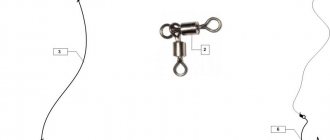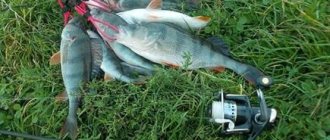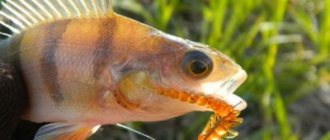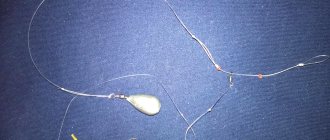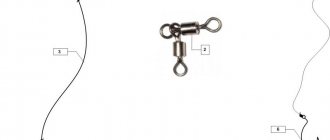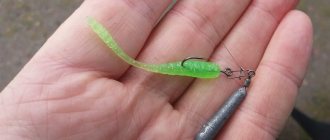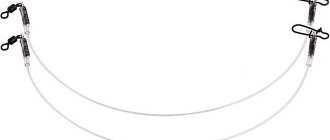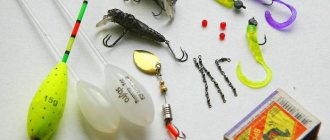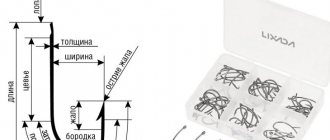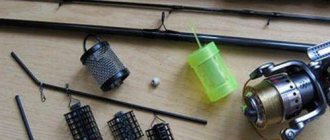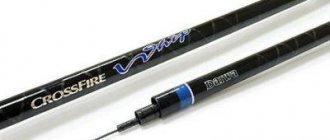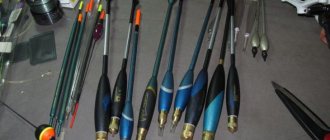Advantages and disadvantages
Advantages:
- Fishing for pike with a retractable leash allows you to move the bait at a slow pace directly at the bottom, and when retrieving, the horizontal component predominates;
- You can catch pike using this method in places where the use of other types of equipment is difficult: in stones, in snags, in thickets of grass;
- the weight of the sinker does not have a significant effect on the animation of the bait, so you can use heavy weights to achieve long casting;
- when fishing for pike with a retractable leash, it is possible to provoke even passive fish to bite;
- the use of a retractable leash allows for different types of animation of the bait.
Flaws:
- When fishing in the “strongest” places, the sinker may get caught. In such a situation, it is advisable to use Texas equipment;
- a significant length of the leash carrying the bait leads to periodic overlaps and tangling of both leashes with each other and with the main fishing line.
Equipment and installation of the outlet leash
You can make a diverter leash directly while fishing, but it is better to take care of ready-made installation of the equipment at home.
Tips for fisherman: From what date is the ban on pike fishing - Choosing the best
Use braided line
for better rig sensitivity. It does not stretch when pulled and allows you to transmit any pokes from the fish, as well as better probe the bottom. The diameter depends on the intended catch; beginners are advised to take a fishing line with a diameter of at least 0.12 mm (braid), it will withstand 8 kg of direct load, and is also much less tangled.
A sinker is tied to the end of the fishing line.
Sinkers are most often used weighing 15-30 grams of pear-shaped, Cheburashka or Tyrolean sticks (which are protected from snagging in soil strewn with large stones).
The weight is selected depending on the depth at the fishing spot and the desired casting distance. An ideally selected sinker allows you to make long casts, and after falling to the bottom after 3-4 turns of the reel, it must rise from the bottom and not drag along it.
A leash 1 meter long is tied 30-40 cm above the sinker.
This leash is made from monofilament or fluorocarbon line. The advantages of these lines are their low visibility and a predator will undoubtedly attack a moving bait. Fluorocarbon fishing line is preferable, but has its drawbacks in terms of low breaking load.
A leash is tied at the end of the fishing line
either a swivel with a clasp for conveniently changing the bait (it is advisable to use small swivels), or the bait directly.
A triple swivel (carabiner), which can be purchased in a store, will help you connect all three pieces of fishing line (main line, 30 cm lead to the sinker, and 100 cm lead to the bait). In addition to being less tangled, it will save you from twisting the line, and the equipment will also become more convenient in terms of transportation.
For the most part, when fishing with a retractable leash, sinkers weighing 5-30 grams . The basic rule: after falling during retrieving, the equipment should not drag along the bottom constantly or bounce at the slightest movement of the rod. Its behavior is influenced by many factors: the strength of the current, the depth of the reservoir, the nature of the bottom, the weight of the bait, the nature of the wiring. When fishing in an unfamiliar body of water, it is worth taking several weights of different weights in order to vary the equipment depending on local conditions.
Installation methods
There are several ways to install the main leash. The simplest is to tie both leashes to a simple swivel. But the following methods are more often used:
Deaf
For this type of installation, a triple swivel . The main line is tied to one ring of the swivel, and the cargo leash and the leash with bait are tied to the other two.
Sliding
Such equipment is also called “Moscow” , since it is believed that it was invented by Moscow spinning athletes. Installation is carried out as follows:
- A swivel with a weight leash attached to it is put on the main line;
- another swivel is tied to the main line;
- A leash with a hook is tied to this swivel.
Expert opinion
Knipovich Nikolai Mikhailovich
Zoologist, hydrobiologist. I am interested in fishing at a professional level.
Healthy! Experienced spinning anglers knit both cargo leashes and hook leashes in advance and wind them on the reel. If one of the leads breaks, you can quickly replace it with a new one.
Tactics for fishing with a retractable leash
Using a retractable leash, pike can be caught both in standing reservoirs and on rivers with currents of varying strength. Moscow equipment does not require much fuss or speed; fishing is carried out slowly and thoughtfully.
In lakes and slow rivers, it makes sense to work for a long time from one point, using fan casts with different wiring techniques to fish the reservoir. Often the bait is played in one place, like a drop shot.
The drop shot is also a spaced jig. Its difference from the Moscow rig is the absence of a leash. The bait is attached directly to the main line 30-40 centimeters above the sinker.
On a river stream they fish with a Moscow rig both downstream and against it, as well as across the stream. Each of the tactical techniques has its own distinctive features and makes the bait play in a special way.
The right tactics yielded results.
Fishing tackle
Certain requirements are put forward for individual components of spinning equipment for pike fishing with a retractable leash.
Spinning rod
Since in most cases the leash with bait is of considerable length, for ease of casting it is advisable to use a spinning rod with a length of at least 2.4 meters . When fishing from the shore, especially if the angler is surrounded by bushes, using a rod 2.7-3.0 meters long will be more than justified.
In order for the spinner to have access to various methods of bait animation, he should choose a rod that has a fast or medium-fast action, and not extra-fast, as when fishing with a jig.
The spinning test depends on the weight of the load used.
Coil
For pike fishing, reels from 2500 in size (according to the Daiwa and Shimano classification) are used. The reel must be balanced with the rod.
Main line
As a rule, a braided cord is used as the main fishing line. It provides the required casting range, high sensitivity and the necessary strength. The thickness of the cord is not critical, since the breaking load of the leash is always lower.
Leashes
Cargo leash
The cargo leash is made of monofilament fishing line. The fishing line should have a breaking load less than that of the main cord. A swivel is attached to one end of the leash to attach the sinker. The length of the cargo leash is 20-50 cm.
Leash with hook
A leash with a hook is made of monofilament fishing line or fluorocarbon. The latter is preferred due to its lower elongation and greater rigidity. In addition, it is less susceptible to abrasion.
The length of the leash with hook is approximately a meter. It can be longer or shorter depending on fishing conditions and pike activity. The diameter of the leash line is chosen based on the size of the intended prey - usually lines with a thickness of 0.25-0.4 mm are used.
Metal leash
is tied to the end of the leash with a hook , which prevents pike teeth from cutting the bait . You can make a leash yourself from leash material, or purchase it at a fishing store. The rigidity of the leash is not as fundamentally important as when fishing by twitching or when fishing with girders. The leash length is usually 15-20 cm.
Sinker
For better passage through obstacles, use sinkers that have an elongated shape : pears or olives. The weight of the sinker is determined by the depth at the fishing site, the absence or presence of a current, as well as the required casting distance.
Expert opinion
Knipovich Nikolai Mikhailovich
Zoologist, hydrobiologist. I am interested in fishing at a professional level.
Attention! When fishing on rocky soils, it is recommended to use ballerina weights or “scriber” weights. With such loads, there is no need for a cargo leash, since you can directly attach the sinker and the leash with a hook to the fastener.
Lures
Most often, when fishing for pike with a retractable leash, the following baits are used.
Silicone
Silicone baits are most common when fishing with a retractable leader when catching any predatory fish, not just pike. But it is precisely for the toothy predator that the No. 1 bait is the twister . Vibrating tails on a slow retrieve do not fully demonstrate their qualities, and silicone worms are not as attractive to pike as they are to pike-perch or perch. The color of the bait is chosen based on the preferences of the pike in a particular reservoir; the predator prefers large twisters to small ones.
Wobblers
Wobblers used for catching pike with a retractable leash must have a shallow depth. Most often, floating wobblers are used, less often suspenders. The wobbler must weigh less than the sinker, otherwise the accuracy and casting range are sharply reduced.
Natural baits
With a retractable leash, pike are caught with live bait, but more often with a tackle with a dead fish.
Hooks
Fishing with silicone baits can be done with single, double and triple hooks. If there are no obstacles at the bottom, then you can use single hooks with an open tip, as well as doubles and tees. If you have to fish where there are stones, snags and thickets of grass at the bottom, the choice falls on an offset hook. The offset hook is equipped with a non-hooking version. The size of single hooks for catching pike on a retractable leash is 3/0-5/0, double hooks are 1.0 – 2/0.
Tackle for catching pike vertically in snags and cluttered places
First fishing trip with new gear
Tips for fisherman: How to catch pike on a fishing rod with a float - What to choose for fishing
I couldn't wait to test my fishing gear. Having chosen the right time, I went to the bay, to my trusted place. I stopped the boat not far from the flooded trees. The day was not hot, with a light wind. On the surface of the water, here and there splashes of small fish were noticeable - the perch was “chasing” small fish.
You should look for pike perch on the edge, shell rock, whirlpools, snags; at night it comes out into shallow water. To catch pike perch, use baits of white-red, pearlescent, bright yellow, orange, and lemon colors.
The sizes of baits for perch start from 2-3 cm. A large perch from 1 kg is able to completely swallow a worm 12 cm long.
The length of the leash usually averages 1.2-1.5 meters. But when the fish is capricious, they put a short leash up to 50 cm, or increase it to 2 meters.
Next is a popular video from the Shcherbakov brothers on fishing with a retractable leash.
The wiring for the diverter leash is very diverse. Perch can be caught both using a classic jig step and evenly dragging along the bottom. But alternating stretches, pauses and twitching with the tip of the rod are more effective. The intensity and activity of various dotted lines is selected depending on the activity of the fish. Active fish respond well to sudden movements and fast reeling. To seduce passive fish, stretches are made short, pauses are increased to 5 seconds.
Fishing for pike perch
To catch pike perch on a retractable leash, more powerful offset hooks are required, since breaking through the mouth of a fanged one is much more difficult than hooking a perch. Vibrotails, twisters, and foam fish are used as baits.
Pike perch should be hooked with a sharp and strong movement, so a strong and sharp hook is a must. Sometimes the pike perch opens its mouth, releases the bait when it encounters an angler, and leaves.
You should look for pike perch on the edge, shell rock, whirlpools, snags; at night it comes out into shallow water. To catch pike perch, use baits of white-red, pearlescent, bright yellow, orange, and lemon colors.
Pike fishing
It is a mistake to believe that a retractable leash is not used to catch pike. It is not uncommon for pike to be caught as by-catch when fishing for perch on a diverter leash.
The sharp teeth of pikes require the use of an additional metal leash, which is tied between the hook and the line of the leash. It is also advisable to use a winding ring when connecting an offset hook and a metal leash. The length of the metal leash must be at least 30 cm. A medium-sized pike easily swallows a 10 cm bait and a 20 cm leash.
The size of lures for pike should be at least 8 cm, but pike also don’t mind biting with a 5 cm twister. It is believed that the color of the bait for catching pike does not matter. The game of bait is important.
You should look for pike on the edge of the grass, on the edges, in holes.
Sinkers are most often used weighing 15-30 grams of pear-shaped, Cheburashka or Tyrolean sticks (which are protected from snagging in soil strewn with large stones).
Pike fishing seasons
It is known that in summer pike is more passive than in autumn or during the spring feeding season . It is in hot weather that a retractable leash is an effective equipment for catching predators. But also late autumn before freeze-up can be a good time to use a retractable leader with large baits.
Materials, their advantages and disadvantages
Pike leashes in the classic version are made of steel. The thin core allows it to withstand tearing under heavy loads and resist abrasion. But the disadvantages of steel are its large mass and high levels of residual memory; moreover, at sharp bend angles, the material is prone to creases. Tungsten options are much softer than steel and are not subject to oxidation, but also have high memory and are heavy.
The durable material titanium, from which the lightest, most flexible and memoryless leashes are made, is disappointing only with its high cost, comparable for the price of one unit of titanium leash to the cost of a couple of seasons of active fishing when purchasing accessories made of steel and even tungsten. Kevlar, a synthetic fiber, is increasingly being used in pike fishing, claiming to be a universal leader material. It is plastic, not prone to stretching and has virtually no memory effect. But bulkiness and lack of resistance to sharp teeth hinders the leadership of this type of material. The same can be said about fluorocarbon. The general characteristics of plasticity and high transparency provide obvious advantages for pike fishing and especially for passive fish, but durability requires better results and expectations.
Fishing technique and tactics
Pike fishing tactics involve searching for promising fishing spots . For fishing with a retractable leash, it is advisable to find areas of the reservoir where the predator is hiding in ambush. Such places can be various uneven bottom topography, snags and thickets of grass.
The fishing technique involves selecting the required weight of the load . The sinker should be neither too light nor too heavy. The weight of the sinker must ensure casting the required distance and constant contact with the bottom when retrieving. After the bait is delivered to its destination, the wiring begins. Having felt the bite, the fisherman must hook and begin fishing.
Expert opinion
Knipovich Nikolai Mikhailovich
Zoologist, hydrobiologist. I am interested in fishing at a professional level.
Attention! Due to the fact that when fishing with a retractable leash, long rods are used, and the leash itself is of considerable length, it can be quite difficult to take prey. We recommend using a landing net with a long handle.
Sliding swivel
Many sports fishermen present this equipment as the simplest, most convenient and practically no alternative to the outlet. Indeed, this installation has many advantages: high sensitivity, low percentage of leash twists, ease of manufacture.
It is mounted as follows: a small swivel is launched along the main line, to which a sinker of the required weight is tied on a leash 15-40 cm long. After this, another swivel is tied to the end of the main line, to which, in turn, a long leash with bait is attached. As a result, the bite is transmitted directly to the angler’s hand along the main line, and the sinker is not involved in the process of registering the bite.
The only thing that confuses me is that there are too many swivels on the gear. Is it possible to get rid of one of them and build the equipment on a single fastening “anti-twist” element? Yes it is possible.
The easiest way to get by with one swivel is to use a triple swivel and tie the main fishing line, a leash with a sinker and a bait to its three rings, respectively. Such equipment sometimes allows the thin leader line to be twisted behind the side ring of the swivel, but overall it works very well. Just before splashing down the rig, you should always slow down the line a little so that the leash straightens out while still in flight and lies on the water behind the sinker. But it should still be recognized that this equipment is not the simplest, cheapest, most reliable and effective.
The easiest way is to assemble the outlet on one ordinary swivel. To do this, we tie the main line and a leash with bait to the top ring, and a leash with a sinker to the bottom ring. Numerous tests on reservoirs with and without current have shown that this particular equipment is the simplest and most reliable, representing a similarity to the Gardner paternoster, but made on the basis of a single swivel. Fishing with a paternoster is simple and convenient.
Posting types
Drawing
Drawing is nothing more than slow, even drawing . Periodic twitching of the tip of the spinning rod is encouraged.
Dot-dash
Dot-dash wiring, otherwise called dotted , involves periodic short jerks with the tip of the rod with short pauses between them.
Twitching
Twitching is carried out in the same way as when fishing with wobblers. Sharp jerks , during which the movement of the bait accelerates, are interspersed with long pauses, when the bait gradually comes to a stationary state.
Dancing on the spot
This wiring is easiest to do when fishing in the current. After making several turns with the reel handle, the bait is stopped and the tip of the rod is made to oscillate , during which the bait moves back and forth.
Fishing technique with Moscow rig
Moscow equipment is used in places where traditional jig gives poor results. These could be sharp edges that the jig bait simply flies past, local anomalies, and the like.
The rate of fishing with Moscow equipment is very slow, which denies the possibility of using it as a search engine. At the same time, it is with it that it becomes possible to fish literally every centimeter in the selected area.
This is also facilitated by a certain independence of the behavior of the equipment from the weight of the load. If in a jig or some other spaced equipment the weight of the load is selected with strict reference to the fishing conditions (depth, current, wind, fish activity), then in a retractable leash we have the opportunity to choose the load that is convenient for us. For example, if in a certain place weights of 10-12 grams are used for jig fishing, then you can put one and a half to two times more weight on the Moscow equipment.
Thus, the casting range will increase significantly and the equipment will not be carried away by the current, if there is one. Despite this, the Moscow rig is in no way a replacement for the jig, but serves as a complement.
The wiring of the Moscow rig can be very different, depending on the type of bait and the fish that is intended to be caught.
- Actively playing baits allow slow, even retrieve. However, it wouldn’t hurt to add some variety to it: pauses and swaying the tip of the spinning rod.
- Passive baits, especially slugs and worms, require jerking. Their wiring is somewhat reminiscent of light twitching. But in this case, it is worth paying attention to the strength and frequency of jerks - the bait should move from side to side smoothly, without sudden movements. This approach is most justified in cases where the fish for some reason is in an inhibited state.
However, there are situations when sharp jerks can save you. Cancers and creatures also require animation, but in their case it all depends on the degree of passivity. This means that the more passive the bait, the more active the animation should be. In this case, it appears in the form of short and fairly frequent, but light, jerks.
An alternative to a retractable leash when fishing for pike
The main competitors of a retractable leash when fishing for pike are jig, Texas and Carolina rigs. The first is used when fishing on a clean bottom, and if caught with a closed hook tip, then in snagged places, just like the last two methods. Pike are rarely caught with a drop shot, due to the fact that it is difficult to attach a metal leash to this equipment.
What is a diverter leash?
A retractable leash is a spaced jig rig. In rigs of this type, the bait with the hook is located at a considerable distance from the load. Jig is a fishing method that involves constant control of the load and the bottom. And since the bait is located at a great distance from the load, it has greater freedom of action.
The diverter leash is also called the Moscow rig, although the historical validity of this name is highly questionable. It is known that such equipment was used by fishermen back in the middle of the last century, far from the capital, somewhere in the Russian outback.
